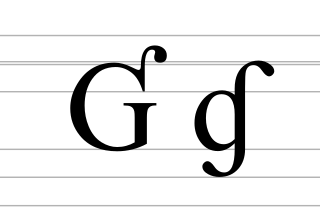
R, or r, is the eighteenth letter of the Latin alphabet, used in the modern English alphabet, the alphabets of other western European languages and others worldwide. Its name in English is ar, plural ars, or in Ireland or.

U, or u, is the twenty-first letter and the fifth vowel letter of the Latin alphabet, used in the modern English alphabet, the alphabets of other western European languages and others worldwide. Its name in English is u, plural ues.

V, or v, is the twenty-second letter of the Latin alphabet, used in the modern English alphabet, the alphabets of other western European languages and others worldwide. Its name in English is vee, plural vees.

The letter F with hook is a letter of the Latin script, based on the italic form of f; or on its regular form with a descender hook added. A very similar-looking letter, ⟨ʄ⟩, is used in the IPA for a voiced palatal implosive.

Esh is a character used in phonology to represent the voiceless postalveolar fricative.

Ou is a ligature of the Greek letters ο and υ which was frequently used in Byzantine manuscripts. This omicron-upsilon ligature is still seen today on icon artwork in Greek Orthodox churches, and sometimes in graffiti or other forms of informal or decorative writing.
Ə, or ə, also called schwa, is an additional letter of the Latin alphabet. In the International Phonetic Alphabet (IPA), minuscule ə is used to represent the mid central vowel or a schwa.

Latin epsilon or open E is a letter of the extended Latin alphabet, based on the lowercase of the Greek letter epsilon (ε). It occurs in the orthographies of many Niger–Congo and Nilo-Saharan languages, such as Ewe, Akan, Lingala, Dinka and Maasai, for the vowel or, and is included in the African reference alphabet.

The letter Ʊ, called horseshoe or sometimes bucket, inverted omega or Latin upsilon, is a letter of the International Phonetic Alphabet used to transcribe a near-close near-back rounded vowel. Graphically, the lower case is a turned small-capital Greek letter omega (Ω) in many typefaces, and historically it derives from a small-capital Latin U (ᴜ), with the serifs exaggerated to make them more visible. However, Geoffrey Pullum interpreted it as an IPA variant of the Greek letter upsilon (υ) and called it Latin upsilon, the name that would be adopted by Unicode, though in IPA an actual Greek upsilon is also used for the voiced labiodental approximant; Pullum called this letter script V and Unicode calls it V with hook.

Ɓ, called "B-hook" or "B with a hook", is a letter of the Latin alphabet and the International African Alphabet. Its lower-case form,, represents a voiced bilabial implosive in the International Phonetic Alphabet. It is used to spell that sound in various languages, notably Fula, Hausa and Giziga. It was also formerly used in or at least proposed for Xhosa and Zulu.

Ɗ, known as D with hook, is a letter of the Latin alphabet. The lower case, represents a voiced dental implosive or a voiced alveolar implosive in the International Phonetic Alphabet. It is used with the same value in the orthographies of various languages, notably some African languages, such as Fula and Hausa, also in Sindhi and used in Shona from 1931 to 1955.

G with hook is a letter of the extended Latin alphabet. In the International Phonetic Alphabet, its small caps form represents the voiced uvular implosive and its lowercase form represents the voiced velar implosive. Because it occurs in the orthographies of some African languages, including some unofficial orthographies of Fula, it is included in the African reference alphabet.

The letter Ʈ, called T with retroflex hook, is a letter of the Latin alphabet based on the letter t. It is used to represent a voiceless retroflex plosive in the International Phonetic Alphabet, and is used in some alphabets of African languages. A ligature of ʈ with h was part of the Initial Teaching Alphabet to represent the voiceless dental fricative.

The letter V with hook is a letter of the Latin alphabet, based on an italic form of V, although it more closely resembles U. It is used in the orthographies of some African languages such as Ewe, and Shona from 1931 to 1955 to write, like the pronunciation of ⟨v⟩ in "van" using both lips. In Mossi (Mooré) it is used to write, like the pronunciation of ⟨oo⟩ in "foot". In Kabiye and Ikposso it is used to write, like the pronunciation of ⟨oo⟩ in "food". It is also used in the North American language Choctaw to write, a schwa, like the pronunciation of ⟨a⟩ in "again".

Ƴ is a letter of the Latin alphabet, formed from Y with the addition of a hook. It is used in some African languages, such as Fula to represent a palatalized glottal stop,, and in Hausa to represent a creaky voiced palatal approximant. In Noon, a language spoken in Senegal, ƴ represents a voiced palatal implosive.

Ƈ is a letter of the Latin alphabet, derived from C with the addition of a hook. It is used in African languages such as Serer.

A with hook above is a letter of the Latin alphabet formed by addition of the hook above diacritic to the letter A. It is used in the Vietnamese language.

The Latin script is the most widely used alphabetic writing system in the world. It is the standard script of the English language and is often referred to simply as "the alphabet" in English. It is a true alphabet which originated in the 7th century BC in Italy and has changed continually over the last 2,500 years. It has roots in the Semitic alphabet and its offshoot alphabets, the Phoenician, Greek, and Etruscan. The phonetic values of some letters changed, some letters were lost and gained, and several writing styles ("hands") developed. Two such styles, the minuscule and majuscule hands, were combined into one script with alternate forms for the lower and upper case letters. Modern uppercase letters differ only slightly from their classical counterparts, and there are few regional variants.

The letter Ɱ, called M with hook, meng, or emg, is a letter based on the letter M. Its minuscule ɱ is used to transcribe a voiced labiodental nasal in the International Phonetic Alphabet.

The letter Ƥ, called P with hook, is a letter of the Latin alphabet based on the letter p. It is used in some alphabets of African languages such as Serer.



















